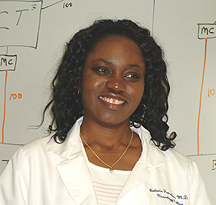C O M M E N T A R Y
NEEDED: A STRUCTURED TOP-NOTCH PROGRAM AT NIH
FOR THE ASPIRING PHYSICIAN-SCIENTIST
 |
Bolanle Famakin |
| T H E N I H C A T A L Y S T | M A Y – J U N E 2008 |
|
|
|
C O M M E N T A R YNEEDED: A STRUCTURED TOP-NOTCH PROGRAM AT NIH |
|
Training
options for the physician
aspiring to become
an independent bench scientist is a topic that needs to be addressed for
clinical fellows who are physicians pursuing basic science research at NIH.
(For the record, “clinical fellows” fall into two categories: those enrolled in
an ACGME-accredited clinical fellowship with some time allotted to research in
the second and third years and those who have completed such a fellowship elsewhere
and have come to NIH specifically to obtain training in basic science
research.)
Currently, physicians who want to
perform patient-oriented research can obtain a Masters in Clinical Research.
However, there is a surprising dearth of options for the physician who has not
gone the traditional M.D.-Ph.D. route and wants to pursue basic science
research after a medical residency and fellowship.
Right now, the quality and relevance
of training for clinical fellows who have come to NIH to gain experience in
basic research depends largely on the mentor’s investment in the fellow’s
objectives.
With no time-defined structured
program that flexibly accommodates the physician’s research objectives, there
is no guarantee he or she will acquire the desired research expertise or the
tools to creatively ask and answer complex questions.
Physicians interested in pursuing a
Ph.D. at this stage should be able to do so without having to take the same
classes as a traditional Ph.D. student fresh out of undergrad, that is,
participating in the Graduate Partnerships Program (GPP). And should a
physician choose to pursue a Ph.D. through the GPP—a highly structured,
full-time program—there is no provision for seeing patients on a limited
basis in conjunction with coursework and basic research training.
NIH, with interested degree-granting
institutions on board, can provide a program that enables the physician to
pursue focused medical specialty–research—a program with targeted
relevant coursework, some structured mentoring, time to see patients, and a
Ph.D. offered at the end of a defined period of time.
Physicians who have completed their
medical training can bring much more to basic science research, especially
translational research, if given the opportunity to pursue Ph.D.-like basic
research training at the end of their formal medical training. A physician at
this point in training has defined scientific interests centered on a chosen
subspecialty. This situation
contrasts with the traditional M.D.-Ph.D. route: A student completes dissertation research without having
chosen a medical specialty and therefore is not poised to formulate research
questions relevant to a given medical field or disease process from the
perspective of a health provider.
It is also more efficient to have
physicians pursue basic science research training after they have completed all
formal medical training and before they have secured a tenure-track position.
During this transitional period, physicians can also still see patients on a
limited basis and hence have the opportunity to pursue basic research questions
bidirectionally—from bench to bedside and from bedside to bench. This
route may also be more attractive to physicians interested in bench science
than is the typical M.D.-Ph.D. pathway, which entails a lengthy period of up to
nine years of consecutive training.
As things now stand, physicians
interested in basic science research pursue this training largely on an ad hoc
basis, diminishing their potential to contribute effectively to the translational
research mission of NIH. They are also less able to compete with Ph.D.
postdocs, who have up to nine years of bench training—four during their
graduate training and up to five as postdocs—and who tend to receive most
of the translational awards, for instance, the new K99/R00 awards.
This is an enormous loss that defies
adequate assessment because these physicians tend to go quietly into the world
of patient care—and as a result the field of translational medicine to
bridge the gap between bench and bedside continues to advance at a snail’s
pace.
Clinical Fellow
Stroke Branch, NINDS
Ed.response: Ten years ago, NICHD
physician–scientist Tracey Rouault worked with a group of NIH scientists
to propose a program to bring physician–scientists into NIH labs. Some ICs have begun to do that, but there
is not an NIH-wide program. She
wrote at that time: “Much has been
written about the shortage of MD researchers. We argue that the NIH intramural
program is uniquely qualified to address this critical issue. The NIH intramural program was critical
in providing MD researchers to medical centers in the 1950s–1980s, and we
can play that role again if we design a modern research fellowship
program.” The time has come to
craft such a program.
—Michael
Gottesman
Deputy
Director for Intramural Research